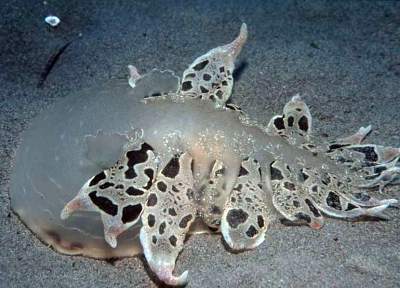
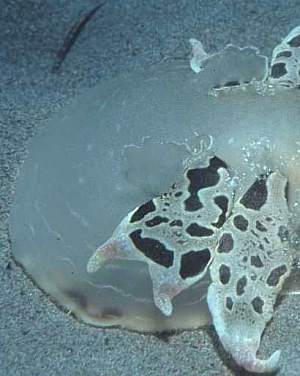
Tethys fimbria
Linnaeus, 1767
Order: NUDIBRANCHIA
Suborder: DENDRONOTINA
Family: Tethydidae
DISTRIBUTION
Mediterranean and east Atlantic coast from Portugal to the Gulf of Guinea.
PHOTO
Antalya, Turkey, Divesite: Kiris, Depth: 14m, June 2002. Size: 25cm. Photo: Adnan Buyuk [ado2000tr@yahoo.com].
Tethys fimbria is the sole species of the genus Tethys. Species of Tethys, and the closely related genus Melibe, have a large oral hood, used in the capture of food, and a set of prominent cerata down each side of the body. In Tethys the cerata are smooth, with a pair of small basal gills, while in Melibe the cerata are usually papillate or tuberculate, and there are no basal gills. Like all members of the family they lack a radula. Internally, Tethys has no stomach plates, the posterior digestive gland forms a solid mass, surrounded by the gonad, while in Melibe there are a ring of stomach plates, the digestive gland is usually diffuse, branching or broken up some way, and the gonad lies in masses beneath the digestive gland.
Tethys fimbria can grow to 30cm, and the large oral hood is fringed with sensitive papillae. The rhinophores are small, mainly hidden in the expanded collar of the sheath that surrounds each one. The large flattened cerata are easily autotomised. The animal is a translucent white except for the blackish brown spots on the cerata, and sometimes on the edge of the oral hood and the foot. Locally common on soft sandy-mud from 20 to 150 meters, where they feed on small crustacea. It is reported to swim well.
Compare this species with others, such as Euselenops, which have adapted for a life in soft sediments.
References:
• Cattaneo-Vietti, R., Chemello, R., Giannuzzi-Savelli, R. (1990) Atlas of Mediterranean Nudibranchs. La Conchiglia, Rome. 264 pages.
• Odhner, N.H. (1936) Nudibranchia Dendronotacea - A revision of the system. Memoires du Musee Royal d'Histoire Naturelle de Belgique, series 2, fasc. 3: 1057-1128. (Pl. 1)
• Schmekel, L. & Portmann, A., 1982. Opisthobranchia des Mittelmeeres. Nudibranchia und Saccoglossa.
Rudman, W.B., 2002 (October 14) Tethys fimbria Linnaeus, 1767. [In] Sea Slug Forum. Australian Museum, Sydney. Available from http://www.seaslugforum.net/find/tethfimb
Related messages
Tethys fimbria from Croatia
August 29, 2008
From: Matthias Mauser
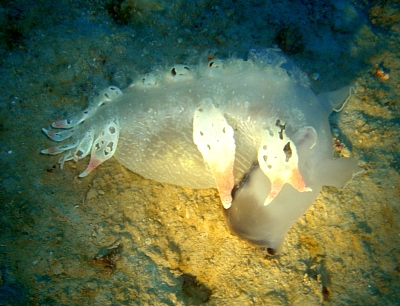
Concerning message #21580:
Dear Bill,
Here is a picture I took last week in Croatia, of a Tethys fimbria. From the distance I first thought it was a plastic bag because of the size, since I never had the opportunity before to see a slug of that size. As you can see the oral hood is not in the position (attached to the ground) as shown on the other pictures here. Unfortunately I don't know why.
Locality: Trogir, 43 m, Croatia, Mediterranean, 22 August 2008. Length: 35 cm. Photographer: Matthias Mauser.
Last but not least, I want to congratulate to this very interesting website.
Best Regards from Vienna
Matthias
m.mauser@m-mauser.at
Mauser, M., 2008 (Aug 29) Tethys fimbria from Croatia. [Message in] Sea Slug Forum. Australian Museum, Sydney. Available from http://www.seaslugforum.net/find/21839Dear Matthias,
The oral hood is not always attached like a disc to the ground. The edge of the hood - with the sensory papillae - is very flexible and it moves around often not in a nice circle, feeling for small crustacea in the sand or mud. In your photo it seems to be interested in something on the right side of its head so the hood has moved over that way to feel around.
Best wishes,
Bill Rudman
The marvellous and strange Tethys fimbria
July 24, 2008
From: Dominique Horst
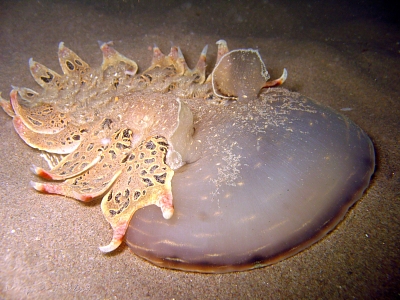
Hello Bill,
Tethys fimbria is a marvellous and strange animal.
I will not forget this first meeting and hope to have a chance for many others in the future. I was able to observe the way it uses its oral hood like a net deployed to capture small animals on the sand. Unfortunately it did not swim.
Locality: Cagnes, 9 m, France, Mediterranean sea, 15 May 2008, sand. Length: 35 cm. Photographer: Dominique Horst.
Kind regards,
Dom.
http://www.bathymed.net/crbst_166.html
dominique.horst@wanadoo.fr
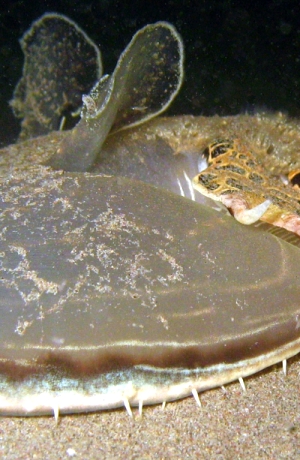
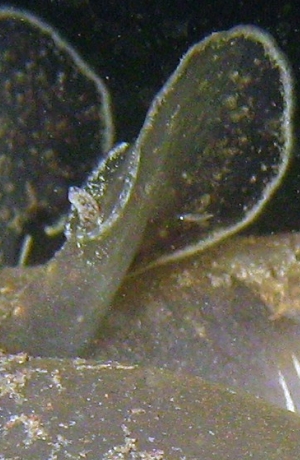

Dear Dom,
If we didn't know it was real, it would be easy to think that Tethys had been invented by an author of science fiction.
Your photos show the greatly enlarged rhinophore sheaths and very small rhinophores very well. In most nudibranchs, the rhinophores are vitally important as the organs of 'smell' which sense the chemicals in the water which will lead the nudibranch to its food. In Tethys, the sense of touch has replaced the sense of smell in the search for food, as can be seen by the development of the huge oral hood, with sensitive papillae around the edge, which search the substrate for the small crustacea that Tethys feeds on. In most nudibranchs, the rhinophores are relatively large and often quite elaborate, but in Tethys, where they apparently are no longer required in the search for food, they are very reduced in size.
A similar reduction in rhinophore size is found in species of the related genus Melibe.
Best wishes,
Bill Rudman
Tethys fimbria from Croatia
October 30, 2006
From: Tibor Beres

Concerning message #14614:
Dear Bill,
Is the slug on my photo Tethys fimbria? Did it lose its lobes?
Length: 10-15 cm.
Locality: Brac island, 15 metres, Croatia, Adriatic sea, , 04 September 2006, sand-detritus. Length: 10-15 cm. Photographer: Tibor Beres.
Thank you and best regards
Tibor Beres
Hungary
Beres.Tibor@mkk.szie.hu
Beres, T., 2006 (Oct 30) Tethys fimbria from Croatia. [Message in] Sea Slug Forum. Australian Museum, Sydney. Available from http://www.seaslugforum.net/find/18043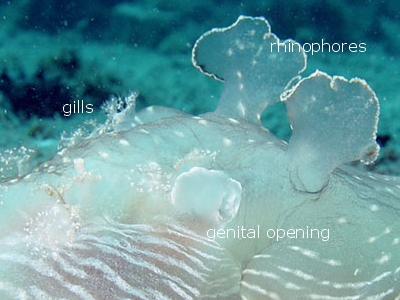
Dear Tibor,
During my recent trip to Europe I visited both Hungary and Croatia. You certainly live in a most beautiful part of the world.
This is indeed a Tethys which has lost its ceratal lobes. All that remains are the large rhinophoral stalks or sheaths, the flap around the genital opening. and the small branched gills which sit at the base of each ceratal lobe. The actual rhinophore in these animals is very small compares to the size of the animal. I guess a chemosensory organ, like the rhinophore, is fairly superfluous in an animal that senses it food by using the small tentacular papillae along the edge of its oral hood to find small crustacea in the sand.
Best wishes,
Bill Rudman
Re: Tethys fimbria from Croatia
November 30, 2005
From: Caryl Buton
Hi there
In response to Bill's question [message #11166], here is my recent observation of Tethys swimming : At nite (8:00 PM) on the Cap d'Antibes (France / French Riviera), 1 Tethys around 8-10cm, at 15m depth on a sandy bottom, close to rocks. It was wandering on the sand but we easily had it "flying" by gently disturbing the surrounding water.
While swimmin, it kept its dorsal outgrowth upward and used its head as a steering oar, right, left, right, left.... Magic !
Locality: Cap d'Antibes / Plage du Graillon, France - Alpes Maritimes. Mediterranean Sea. Depth: 15-17 m. Length: 8-10 cm. 21 november 2005. sand
Caryl
caryl.buton@wanadoo.fr
Buton, C., 2005 (Nov 30) Re: Tethys fimbria from Croatia. [Message in] Sea Slug Forum. Australian Museum, Sydney. Available from http://www.seaslugforum.net/find/15377Dear Caryl,
Thanks for your observations. I have never seen a live Tethys but from photos they ceratinly seems to be as amazing as the Indo-West Pacific species of the related species of Melibe.
Best wishes,
Bill Rudman
Re: Tethys fimbria from Turkey
August 22, 2005
From: Axel Schoeller
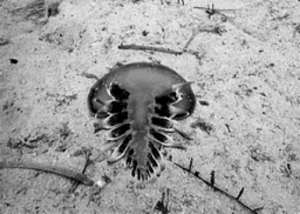
The Tethys fimbria I photographed was within a school of them. There were about 15 to 20 in one area. Unfortunately I ran out of film. However I find them at this location quite often.
Locality: Cape Greco, Cyprus. eastern Mediterranean Depth: -50 meters.
Length: 30-40 cm. August 2005. sandy bottom. Photographer: Axel Schoeller
Regards
Axel
www.aquatec-innerspace.com
aquaxel@aol.com
Schoeller, A., 2005 (Aug 22) Re: Tethys fimbria from Turkey. [Message in] Sea Slug Forum. Australian Museum, Sydney. Available from http://www.seaslugforum.net/find/14614Dear Axel,
I sympathise with you running out of film. I guess as we gradually go digital we will start to run out of memory instead. if you do come across a group of them again, it would be interesting to see some photos of a group. Of course photos of them 'doing things' - feeding, mating, swimming, laying eggs etc are always welcome
Best wishes,
Bill Rudman
Tethys fimbria from Croatia
October 9, 2003
From: Duncan v Vliet
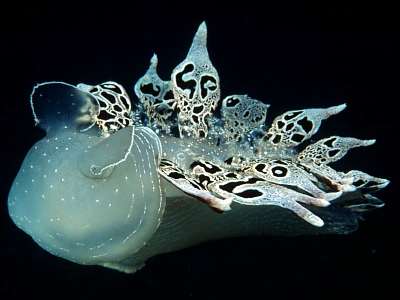
Dear Bill
Here are some photos of Tethys fimbria I took this summer in Croatia.
Locality: Celce village, near Krk. 10 August 2003. Photo: Duncan v Vliet
Can you tell me somthing more about this species?
Thanks,
Duncan
duncan@onderwaterwereld.net
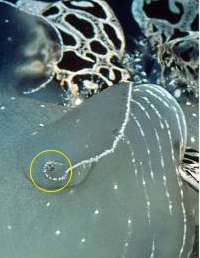

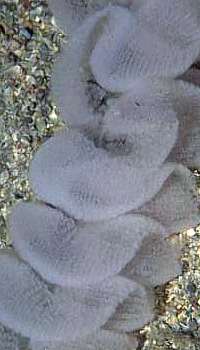
Dear Duncan,
Thanks for these interesting photos. Its nice to get a photo of the egg ribbon. In the close-up alongside you can see the rows of small white eggs. I guess your photo is of an animal swimming. Tethys fimbria is said to be quite a good swimmer but I don't know how it swims. I would be interested to know if it flaps its body from side to side or if it is one of those species which bends its body up and down?
I have also included a close-up of the 'head' [lower left] in which I have ringed the rhinophore, which is very small in this species.
You ask if I can tell you something about this species. Have a look at the Fact Sheet for this species, and at the other messages attached below yours on this page. You will see that this animal feeds by using its great oral veil to feel for and capture small crustacea [shrimps, crabs etc] in the sandy mud. It finds its prey by using the small sensory papillae on the edge of the oral veil to feel in the sand. Many nudibranchs find their food by using their rhinophores to smell chemicals in the water. I guess with Tethys the sense of smell is not very important, which would explain the small size of the rhinophores.
Tethys is closely related to Melibe, a genus of Indo-West Pacific nudibranchs. If you go to the Species List and look for the FAMILY Tethydidae, you will find links to a number of species which would be worth comparing with your animal.
Best wishes
Bill Rudman
Tethys fimbria from Croatia
December 18, 2002
From: Frank Thijssen


Dear Bill.
On the 8th of August this year I saw 3 specimens of Tethys fimbria. (I didn't know that then). One of them was sure 30cm big. I have about 3:45 minute film, where you can see the animal moving. In front the big oral hood becomes bigger, then closes up underneath to catch its food. At the same time its body seems to be just following the oral hood.
Two of them were on the sand bottom, while the third one was heading to some rocks, but when he touched the rock formation he turned around, immediately.
Location: South coast of Croatia, near SV-Marina. Depth: 23m, Temp: 22 degrees
Bottom: Sand & rock from coast. Time: daytime 16:00H
Frank Thijssen
f.thijssen5@chello.nl
Thijssen, F., 2002 (Dec 18) Tethys fimbria from Croatia. [Message in] Sea Slug Forum. Australian Museum, Sydney. Available from http://www.seaslugforum.net/find/8645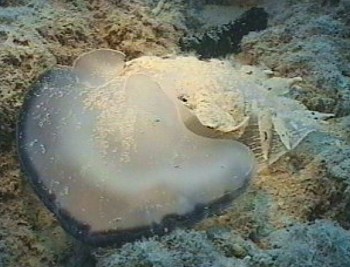
Dear Frank,
Thanks for these wonderful photos. This animal is even stranger than the species of Melibe that I am familiar with in the Indo-West Pacific. It's the sort of animal you would expect to see in a horror or science fiction movie.
Best wishes,
Bill Rudman
Tethys fimbria from Turkey
October 19, 2002
From: Baki Yokes

Dear Bill,
Here is a photo of a Tethys fimbria from Antalya, for the use of the Forum. This species is common on the muddy bottoms of the North Aegean waters, but rarely observed elsewhere around Turkish coast. They are usually found below 20m.
Antalya, Turkey, Divesite: Kiris, Depth: 14m, June 2002. Size: 25cm. Photo: Adnan Buyuk [ado2000tr@yahoo.com].
Best wishes
Baki
bakiyokes@turk.net
Yokes, B., 2002 (Oct 19) Tethys fimbria from Turkey. [Message in] Sea Slug Forum. Australian Museum, Sydney. Available from http://www.seaslugforum.net/find/8148
Dear Baki & Adnan,
Thanks for this great photo. It certainly has similarities to the large Indo-West Pacific species of Melibe, but in those species the large oral hood appears much thinner and more mobile than in Tethys. I would be very interested in a description of how it moves the hood when feeding. Does it stay extended like in Adnan's photo searching along like a metal detector? or does it contract and expand, lifting and falling, as is found in species of Melibe. It reminds me very much of the adaptations I have discussed for Euselenops and the other nudibranchs which live in soft sediments.
Best wishes,
Bill Rudman
